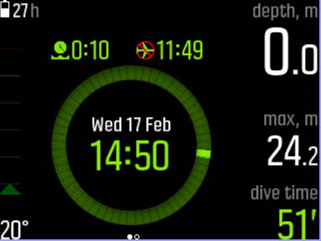Suunto EON Steel User Guide 3.0
Surface and no-fly time
After a dive, Suunto EON Steel displays surface time since the previous dive and a countdown time for the recommended no-fly time. During the no-fly time you should avoid flying or traveling to higher altitude.

No-fly time is the minimum surface time after a dive which is recommended to wait before flying with an airplane. It is always at least 12 hours. For desaturation times shorter than 75 minutes, no-fly time is not displayed. Maximum no-fly time is 72 hours.
If decompression is omitted during a dive and the dive algorithm is locked for 48 hours (see Algorithm lock), the no-fly time is always 48 hours. Similarly, if dive is done in gauge mode (bottom timer), the no-fly time is 48 hours.
With Suunto Fused™ RGBM 2, selected personal setting parameter (-2, -1, 0, +1, +2) is affecting no-fly time. The more conservative personal setting you have, the longer no-fly time values you will see. More aggressive personal setting will result in shorter no-fly time values.
Once the no-fly time calculated by your Suunto EON Steel with Suunto Fused™ RGBM 2 has ended, you can enter and fly with a normal airplane which is pressurized up to 3000 m.
YOU ARE ADVISED TO AVOID FLYING ANY TIME THE COMPUTER COUNTS DOWN THE NO-FLY TIME. ALWAYS ACTIVATE THE COMPUTER TO CHECK THE REMAINING NO-FLY TIME PRIOR TO FLYING! Flying or traveling to a higher altitude within the no-fly time can greatly increase the risk of DCS. Review the recommendations given by Divers Alert Network (DAN). There can never be a flying-after-diving rule that is guaranteed to completely prevent decompression sickness!